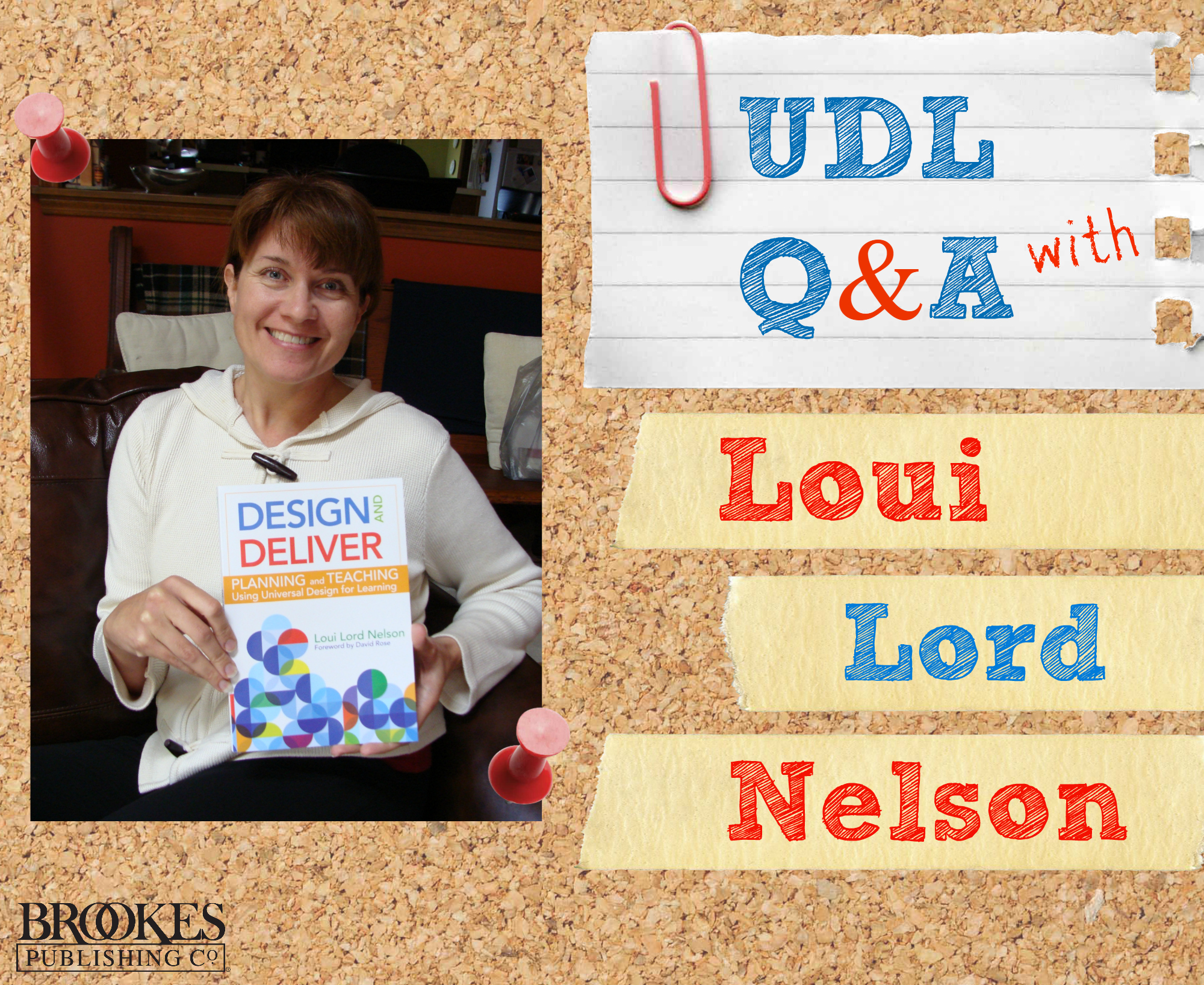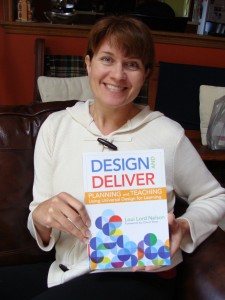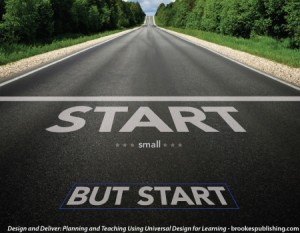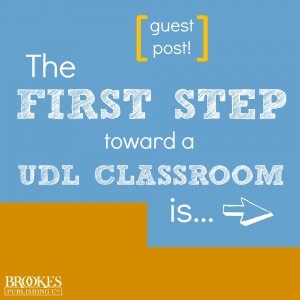“Start Small”: A UDL Q&A with Loui Lord Nelson
February 16, 2016
 Today, I’m thrilled to welcome Loui Lord Nelson, author of the bestselling UDL primer Design and Deliver. Loui’s here to share some real-world tips for getting started with UDL in your classroom.
Today, I’m thrilled to welcome Loui Lord Nelson, author of the bestselling UDL primer Design and Deliver. Loui’s here to share some real-world tips for getting started with UDL in your classroom.
-
Even if a school isn’t planning to switch to a UDL approach, can an individual teacher still adopt UDL principles in the classroom? What are some practical things she can do to get started?
Begin by being reflective. Look at your lessons. What do your lesson goals look like? Are they written in a way that lock your students into using specific tools? For example, you need your fifth grade students to create a story that demonstrates their understanding of clear event sequencing. Notice I wrote “create.” This lowers the potential barrier some students face when using pencils or pens by opening up the opportunity for them to use digital supports or even writing partners. UDL is all about providing options and opportunities to our learners so they can experience learning in ways that have meaning to them, thus allowing them to build their abilities to demonstrate their new knowledge and skills.
 Once you’ve looked at your goal, check to see how you’re formatively assessing your students. Formative assessment is how you investigate your instructional design and make sure it is supporting your students’ growth. That’s why we don’t grade formative assessments. They help us navigate our next instructional steps, and when well-constructed and provide process-focused feedback, they give our students their own piece of navigation; helping them see whether they’re on course or what they need to do to correct their course.
Once you’ve looked at your goal, check to see how you’re formatively assessing your students. Formative assessment is how you investigate your instructional design and make sure it is supporting your students’ growth. That’s why we don’t grade formative assessments. They help us navigate our next instructional steps, and when well-constructed and provide process-focused feedback, they give our students their own piece of navigation; helping them see whether they’re on course or what they need to do to correct their course.
These two suggestions may not sound very “UDL” because I haven’t talked about the vocabulary of UDL: the principles, the guidelines, the checkpoints. But I actually did. The principle of engagement and the guideline of providing options for sustaining effort and persistence ask us to heighten the salience of goals and objectives while varying demands and resources. The construction of that goal is key to making the lesson topic important and accessible to the learners. And the principle of action and expression through the guideline of options for executive functions guides us to enhance our students’ capacity for monitoring progress. Formative assessment is one way students can participate in monitoring their own learning.
-
Say a busy teacher loves the idea of UDL but is intimidated by the time investment involved in changing the way she teaches. What advice would you give to that teacher so she can support every learner without burning out?
 We all love saving time. Using past lesson plans. Sharing resources. Leaving a professional development with ideas or tools we can use the next day. We each have our own ways of saving time. My way is to start small. Focus on one guideline or checkpoint and use that to make a change to your learning environment that you can sustain. That way, there’s no extreme investment of mental-energy or physical time.
We all love saving time. Using past lesson plans. Sharing resources. Leaving a professional development with ideas or tools we can use the next day. We each have our own ways of saving time. My way is to start small. Focus on one guideline or checkpoint and use that to make a change to your learning environment that you can sustain. That way, there’s no extreme investment of mental-energy or physical time.
Let’s say you decide to begin with the principle of representation and you focus on providing options for perception. You think about how you typically display information in your classroom and decide to make a change. I’ll give a low-tech and high-tech example.
Example 1: Your school doesn’t have a lot of technology. You use your overhead projector each day to provide your students with their lecture notes. You normally write with a black marker. Today, you decide to use different colors to emphasize different points and you provide your students with colored pencils so they can do the same on their papers. You have also realized that some of your students seem to miss the key concepts and vocabulary words when you give notes even through you talk about them. You decide to write those words with bigger letters. You even circle them while you’re talking about them. It’s a simple change that feels comfortable and you can begin to use in a variety of your lessons. Students have the option of using the colored pencils, but you encourage each of them to individualize their notes to emphasize the key points.
Example 2: Your school has an interactive white board in each classroom, but you’re intimidated by the thing. Every day, you project information on it and you’ve recently become more comfortable in using the pens to underline information that’s projected. Now, you’ve decided to dig into the resources that come with the software. With the help of a teacher partner, you learn about the wide collection of still photos and realize that there are plenty of examples you can use for your lesson on comparing and contrasting. You can choose to have the name of objects show up below the picture or have the students move the word so it’s under the correct object. Instead of looking at a list of words, your students can see the words and associated pictures. You begin to brainstorm other ways you can use those still pictures and realize there are plenty of concrete and abstract concepts you can demonstrate with them.
These are two very small ways teachers could provide some initial options for perception. Hopefully, both teachers would move forward and expand their repertoire of options. The overall focus of this response, however, are the three points I shared above: (1) Focus on one guideline or checkpoint, (2) use that to make a change to your learning environment, and (3) sustain that change until it becomes a natural part of your practice.
-
What are some ways that implementing a UDL approach can actually make a classroom more efficient in the long run?
There are two pieces here. Underlying UDL is the concept of variability. That concept addresses the fact that our learning brain operates differently based on the context. Context is not only how the information is delivered but also the design of the environment. Your environment deeply influences how you learn and that environment is ruled by how you interact with it, meaning, how you feel.
 Every classroom in the world experiences variability. Even if every child looked identical, they would not learn identically. Moving from that point, most teachers have students who have learning challenges, aren’t reading on grade level, appear to flow along with everyone else, learn concepts more quickly than their peers, and everything beyond and in between. This is precisely why UDL suggests we design our learning environments and lessons to provide students with a variety of ways to access the skill or information and then a variety of ways to demonstrate how well they’ve learned the skill or information. The first part of that last sentence talked about the learning environment and that’s where the efficiency comes in.
Every classroom in the world experiences variability. Even if every child looked identical, they would not learn identically. Moving from that point, most teachers have students who have learning challenges, aren’t reading on grade level, appear to flow along with everyone else, learn concepts more quickly than their peers, and everything beyond and in between. This is precisely why UDL suggests we design our learning environments and lessons to provide students with a variety of ways to access the skill or information and then a variety of ways to demonstrate how well they’ve learned the skill or information. The first part of that last sentence talked about the learning environment and that’s where the efficiency comes in.
The learning environment is where you are teaching. Most of the time that’s in a specific classroom, but sometimes you’re leading instruction in other locations. It’s still a learning environment and you still have a lot to do with it. Making learning approachable for all of your students is a great place to start. As you learn more about and begin to implement strategies associated with the engagement guidelines, your students become more connected to the learning environment and to learning. They feel safe to explore, make mistakes, receive guidance, work with others, check on their own understanding, identify ways to maintain their motivation, and reflect on their own learning. When learners become purposeful and motivated, two skillsets CAST identifies as expert learners, they take a step toward self-direction and efficiency of learning. That creates a more efficient classroom.
***
Thanks to Loui for being here today and sharing her UDL wisdom with us!
Preview Design and Deliver, a reader-friendly guidebook on how to use the three key principles of UDL–Engagement, Representation, and Action & Expression.
See Loui Lord Nelson’s picks for best online UDL resources.
Read the post: Your first step toward a UDL-designed classroom








Write a Comment
Your email address will not be published. Required fields are marked *
comments
Anke says
I would hope that we can agree that as an educator our job is to prpaere our students for the future, whatever path they choose to pursue. In doing so, we have to understand that our students will have to be able to be creative in their own way and be able to problem solve. We can do this in the classroom by, yes providing an excellent rubric and allowing multiple resources. Many teachers see differentiation as more work for them; so what!? Remember our overall goal is get them prpaered at all costs. Not every task is performed the same way day in and day out in the work field. Technology is a great tool we can use to allow students to explore and be creative in their demonstration(s) to us letting us know if they have mastered the content.
Post a Comment